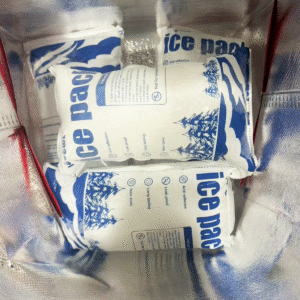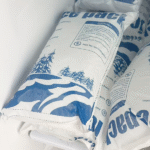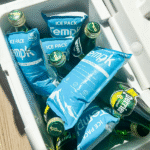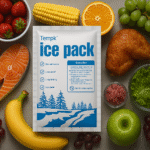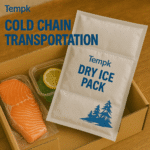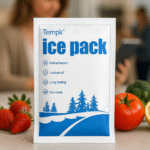How to Pack Ice Cream with Dry Ice in 2025
You want rock‑solid pints at the door, not slush. Here’s how to pack ice cream com gelo seco the right way—step‑by‑step methods, exact ice math, and compliant labels—so your shipment holds 0°F (‑18°C) for 24–72 hours without waste. Most small coolers need 5–10 lb de gelo seco por 24 horas; thicker insulation and hot routes need more.
-
How to layer pints and dry ice for even cold on 24–72‑hour routes
-
How much dry ice to use with a simple, testable calculator
-
Which insulated shipper (EPS, Pur, VIP) fits time and budget
-
How to label and vent packages for USPS/UPS/FedEx compliance
-
When gel packs help—and when dry ice must lead
How do you pack ice cream with dry ice step by step?
Resposta rápida: Pre‑freeze pints, pre‑condition the shipper, line with a poly bag, add a base layer of dry ice, pack pints tightly, top‑load more dry ice, preencher todos os vazios, keep vents open, and label correctly. Do not seal airtight; CO₂ must escape. Plano 5–10 lb dry ice per 24 horas for small coolers; increase for thin walls or heat waves.
Por que funciona: Dry ice is ‑109°F (‑78.5°C). Cold gas sinks. Putting most ice acima the pints feeds cold downward and slows heat gain. A “sandwich” (base ice → pints → top ice) evens temperatures and prevents lid warp. Venting avoids pressure build‑up and keeps handlers safe.
Which insulated shipper should you choose for how to pack ice cream with dry ice?
Pick wall thickness by transit time. Usar ~1.5″ EPS for 24–48 h. Aproxime-se 1.75–2.25″ EPS ou PUR/VIP para 48+ h ou pistas quentes. PUR insulates better than EPS; VIP gives the longest hold in the smallest footprint.
| Pack‑out choice | Especificação típica | Melhor para | O que isso significa para você |
|---|---|---|---|
| 1.5″ EPS | Budget foam | 24–36 h | Good for overnight; add buffer ice |
| 1.75–2.25″ EPS | Thick foam | 36–48 h | Two‑day lanes; moderate heat |
| PUR ou VIP | Higher R‑value | 48–72 h+ | Smaller box, Menos gelo, premium price |
Dicas práticas que você pode usar hoje
-
Condição prévia the shipper in a freezer for 1–2 hours.
-
Mix blocks + Pellets: blocks last, pellets fill gaps.
-
Eliminate headspace: paper void fill beats warm air.
Caso real: A creamery shipped 12 pints in summer using a 1.75″ EPS shipper and 18 lb of mixed dry ice with a top‑heavy layout. Delivery at 46 horas: pints arrived rock‑solid; lids intact.
How much dry ice do you need when you pack ice cream with dry ice?
Regra geral: Comece em 5–10 lb por 24 h for well‑insulated small coolers. Scale for thicker walls, payload size, e clima. For 36–48 h, 12 pints often need 15–22 lb. in 1.75–2.25″ EPS. Always validate with a lane test.
Make it predictable: A sublimação depende do isolamento, massa, and airflow. Use a simple estimator, then add a heat‑season buffer (+20% in hot months). Keep most ice above the pints. For long lanes or heat waves, upgrade to PUR/VIP to cut required ice mass and risk.
Dry ice estimator (copy/paste to Sheets)
-
Rate_lb_per_day: comece em 7.5 (ponto médio de 5-10).
-
Route_Factor: 1.0 legal / 1.2 ombro / 1.4 quente.
-
Box_Factor: 0.9 PUR/VIP; 1.0 for 1.75–2.25″ EPS; 1.2 for 1.0–1.5″ EPS.
Exemplo: 36 h, hot route (1.4), 1.5″ EPS (1.2) → =ROUNDUP((36/24)*7.5*1.4*1.2,0) → 19 Libra gelo seco.
| Carga útil (pints) | Box type | Window | Leste . gelo seco | Your takeaway |
|---|---|---|---|---|
| 6–8 | 1.5″ EPS | 24–36 h | 8–12 lb. | Overnight plus buffer |
| 12 | 1.75–2.25″ EPS | 36–48 h | 15–22 lb. | Two‑day lanes in warm weather |
| 18–24 | 2.25″ EPS / Pur | 48–60 h | 25–35 lb. | Long zone‑skips; O fim de semana segura |
Layout that keeps pints hard‑frozen
-
Base layer: 0.5–1″ pellets wrapped in paper.
-
Zona de carga útil: tight rows; no gaps.
-
Side cavities: 0.5–1″ pellet bags on “hot” walls.
-
Camada superior: 1–2″ blocos + Pellets.
This “cold well” evens temperatures and extends hold time.
How do you stay compliant when you pack ice cream with dry ice?
Faça isso sempre: Marca “Gelo seco” ou “Dióxido de carbono, sólido,UN1845, list Peso da rede de gelo seco, use o Aula 9 rótulo (ar), e ventilação the package—no airtight internals. USPS allows dry ice domestically with air limits; international via USPS is prohibited. UPS/FedEx follow IATA PI 954 para o ar.
Por que isso importa: CO₂ gas must escape to prevent pressure build‑up and oxygen displacement. Proper labels keep your parcel moving and protect handlers. USPS air has a 5 lb limit per mailpiece; ground can exceed but must stay surface. International shipments require private carriers and IATA‑compliant marking.
Labeling checklist for how to pack ice cream with dry ice
-
Nome de envio adequado: Gelo seco / Dióxido de carbono, sólido
-
UN1845 clearly marked
-
Peso líquido de gelo seco (kg or lb) do lado de fora
-
Aula 9 Etiqueta de perigo (100 milímetros) for air shipments
-
Embalagem ventilada; do not seal liner airtight
| Operadora / Modo | Key limit | Must‑have marks | Notas |
|---|---|---|---|
| USPS (Ar) | ≤5 lb dry ice | UN1845 + Aula 9 + Peso líquido | Somente doméstico; internacional proibido |
| USPS (Chão) | No fixed limit | “Dióxido de carbono, sólido" + Peso líquido | Surface transport only |
| UPS/FedEx (Ar) | Aqui está Pi 954 | UN1845 + Aula 9 + Peso líquido | Station acceptance rules vary |
Is dry ice always best, or when do gel packs help?
Dry ice is the apenas way to hold a true freeze for ice cream. Gel packs are for chilled ranges. UM híbrido (top dry ice + side gel) can buffer delicate pints or mixed loads and reduce lid warp on long lanes. For 0°F targets, keep dry ice primary.
2025 trends shaping how to pack ice cream with dry ice
Instantâneo da tendência: Brands are shifting from standard EPS to PUR/VIP to shrink box size and dry‑ice mass while extending hold time. Low‑cost data loggers make lane qualification simple. Shippers are “right‑sizing” dry ice with validated calculators instead of rules of thumb, cutting waste and cost.
Último progresso em um olhar
-
VIP goes mainstream: Longer hold in smaller cartons; fewer re‑packs.
-
Monitoramento mais inteligente: API‑enabled loggers prove compliance and reduce claims.
-
Greener CO₂ usage: Better modeling prevents over‑icing without risking thaw.
Insight de mercado: Cold‑chain packaging demand keeps climbing with DTC desserts and e‑grocery. Thicker EPS tiers and VIP adoption support 48–72‑hour windows without premium services—key for margin.
Perguntas frequentes
How long will dry ice keep ice cream frozen?
Sobre 24–72 horas depending on insulation and ice mass. Start at 5–10 lb per 24 h and validate on your lane.
Quanto gelo seco para 12 pints, 36–48 h?
Plano 15–22 lb. in 1.75–2.25″ EPS with a top‑heavy layout; adicionar 20% in heat waves.
Can I ship internationally with USPS?
Não. USPS prohibits dry ice in international mail. Use private carriers with IATA‑compliant labels.
Where should the dry ice sit?
Mostly acima the pints; add side pellet bags on hot walls to even temperatures.
Is venting mandatory?
Sim. Inner liner and outer carton must allow CO₂ to escape; Nunca sele hermeticamente.
Resumo & Recomendações
Pontos -chave: You’ve learned how to pack ice cream with dry ice using a layered layout, right‑sized ice (5–10 lb/24 h as a baseline), thicker insulation for longer routes, and compliant marking (UN1845, Aula 9 para o ar). Validate with one test ship per lane and a logger before scaling.
PRÓXIMOS PASSOS (plano de ação):
-
Qualify your lane: Run one test with a temp logger.
-
Pick packaging: 1.75–2.25″ EPS for 36–48 h; PUR/VIP for 48–72 h.
-
Calculate ice: Use the estimator, then add seasonal buffer.
-
Rótulo & ventilação: UN1845, Peso líquido, Aula 9 (ar), Sem focas herméticas.
Sobre Tempk
We engineer lane‑validated frozen pack‑outs—insulated shippers, right‑sized dry‑ice charts, and simple SOPs—so your pints arrive hard‑frozen without overspending on ice or service upgrades. Our kits include compliant labels and logger workflows, backed by technicians who’ve shipped millions of units. Let’s tailor a pack‑out that fits your routes and budget.
CTA: Ready to de‑risk your frozen launches? Contact Tempk for a 15‑minute packaging review.






